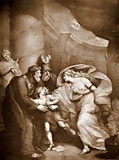

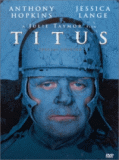
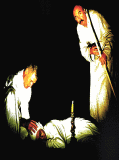
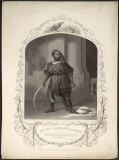
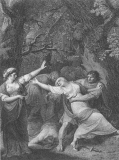

|
Main
Page
|
[Sources of the Images: 1 / 2/ 3/ 4/ 5]
![]()
|
E-TEXT
|
|
|
Study
Guide
|
Titus was published first in 1594 in an edition that survives in only a single copy. A second quarto was published in 1600, and a third in 1611. None of these had Shakespeare's name on the title page. It was published among the Tragedies in the 1623 Folio. It is a revenge play modeled on Senecan tragedy, though Seneca probably mediated by Shakespeare's immediate predecessors, Thomas Kyd, George Peele, and Christopher Marlowe. The story is not historical, combining names and events from various moments in Roman history, especially the Lucrece story, which he might have known from Ovid's Fasti or Livy's History of Rome, and on which he composed a narrative poem, Lucrece, published in 1594. 1. T. S. Eliot called this "one of the stupidest and most uninspired plays ever written," and yet it was a popular success on both the stage and I the bookstalls in Shakespeare's time, and it clearly introduces characters and ideas that continued to interest him throughout his career. What is about the play that so offends Eliot? Is he right? 2.Paul in Romans 12:17-20 says "recompense to no man evil for evil" and warns "avenge not yourselves . . . for it is written: Vengeance is mine; I will repay, saith the Lord." What is the play's attitude toward revenge? 3. Think about the politics of the play. What is the form of government in Rome? 4. The Roman past was not merely a past for Elizabethan England; it was the past, their past. How does Rome function here? What kind of culture is it? Think of this Rome in relation to other Roman plays by Shakespeare. 5. Goths: who were the Goths? What is the relation of Romans and Goths in this play? 6. Violence: This play is among the most violent plays of the period (of any period). To what ends does the conspicuous spectacle of violence work in the play? 7. Look at the language of dismemberment in the play? What does it do? 8. Tamora and Lavinia: Tamora is one of Shakespeare's many powerful women, though her power is clearly demonized; Lavinia (what other Lavinia's do you know of?) is a victim. To what degree are these positions functions of character or of circumstance? What roles are available for women in the Rome of this play. 8. Race: Aaron is conspicuously a "moor"; is "race" a significant category in the play? 9. Tone: how would you characterize the play's tone? - in performance it often draws laughter where the horror of the events would seemingly ask for some more sympathetic response. Is this something in the play or a quirk of individual productions? 10. Who (if
anyone) do you feel sympathy for? |
|
Introduction
|
The play is set in Rome. The eldest son claims right to the empire by right of birth. The younger son claims superior worthiness, and right through election. As a third choice the people choose Titus a valiant soldier. Titus himself chooses the traditional English model, inheritance by the eldest son. The sons of Tamora, Queen of the Goths, rape Titus's daughter Lavinia. They cut out her tongue, but she writes their names in sand. Titus kills the sons and feeds their remains in a pie to their mother. |
|
Links
|
|